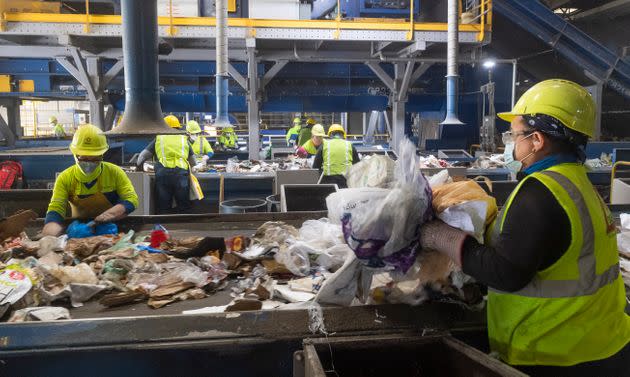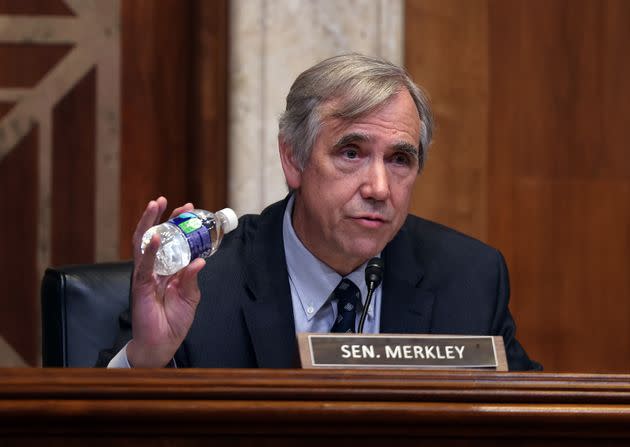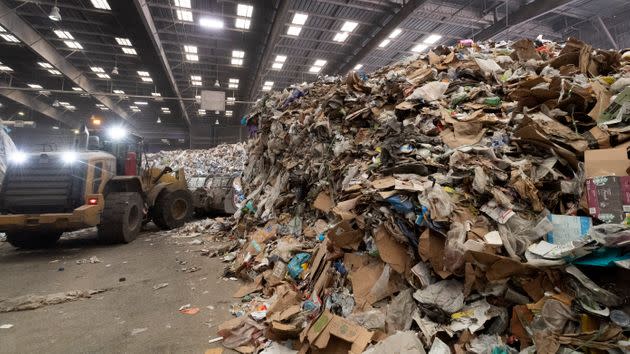Can We Trust Corporations To Deal With Their Own Waste?

On June 3, the World Wildlife Fund and the American Beverage Association issued a joint memo on the dangers of overproducing and under-recycling plastics, which include contributing sizably to climate change and filling our world with plastic pollution.
It was an odd marriage: WWF is a champion of ecological causes and the ABA represents multibillion-dollar corporations like Coca-Cola and PepsiCo. ABA appeared to be telling on itself when it comes to the industry’s abundant waste.
The memo endorsed a different kind of recycling policy known as extended producer responsibility, or EPR, which makes corporations responsible for recycling the products they produce, rather than towns and taxpayers. The logic is that it will push companies to design more sustainable products to avoid costs.
Businesses haven’t exactly lined up to participate in EPR schemes in the past, given that its central idea is making them responsible for all their waste. But that’s started to change, says John Hocevar, the oceans campaign director at Greenpeace. “With so much concern around plastic pollution, they have, for the most part, realized that they can’t just be against everything.”
Now the ABA finds itself on the same side of the issue as leading environmental organizations like Greenpeace, Surfrider and some chapters of the Sierra Club. It’s certainly not the typical acrimonious dynamic between big business and environmentalists, exemplified by the Sierra Club’s June 16 announcement that it is suing Coca-Cola for misleading consumers about its recycling practices.
Both the big environmental groups and the ABA seem to agree that EPR is the solution to America’s growing pile of plastic. But other sustainability advocates are convinced that something is off here and that EPR’s fans in the business world are just taking advantage of an opportunity to undermine the whole recycling system.
“It’s ludicrous that the people making the pollution are the ones to solve it,” said Maurice Sampson, the eastern Pennsylvania director of Clean Water Action.
EPR renews a longstanding, fundamental debate around environmentalism: Is there a way to cooperate with corporations without ceding too much control?
Sampson and others think the move toward EPR should be viewed with skepticism, not enthusiasm. “We can’t blame a rattlesnake for being a rattlesnake,” he said. “Just remember which end bites.”
Upending Our Current Recycling Reality
Recycling in the United States usually works like this: Towns and counties contract with a variety of enterprises that collect, sort and recycle or dump everything their residents toss out.
What isn’t recycled — and that includes more than 90% of plastics — gets sent to a landfill or incinerated. What is recycled isn’t always turned into the next generation of goods here in the U.S., either. Until recently, around half of the nation’s reclaimed plastics were exported, with China the biggest buyer.
The U.S. sent nearly 700,000 tons of used plastics to China in 2016, where cheap labor could be used to sort and recycle the plastic into a host of products to fuel the country’s rapid economic expansion. But as China’s economy has slowed and its own garbage-producing middle class has grown, the country has tightened its standards and bought far less of the world’s trash, cutting off a huge revenue source for American waste management systems.
In 2018, the price of recycled high-density polyethylene, the type of plastic outdoor furniture is made from, dropped 60% from its 2014 high. Ditto for other types of recyclables. The price of collection, processing and the like became more expensive than market values for recycled materials.
Suddenly, towns went from making tens of thousands of dollars selling their recyclables to paying hundreds of thousands to get it off their hands. Meanwhile, the U.S. continues to produce more than 30 million tons of plastic per year without the capacity to handle it.

Without an easy destination for America’s recycling, the enormity of our waste problem becomes impossible to ignore. Enter EPR.
For a long time, the idea was relegated to only the most difficult-to-recycle goods, like batteries or paint. But market changes have made it a more attractive solution for other materials. The European Union already uses EPR for various packaging materials, and Canada has an array of provincial programs.
EPR can work in different ways, from companies simply reimbursing municipalities for the cost of recycling the materials they produce to companies overseeing the entire recycling process.
The idea is catching on in the U.S. now. In March, Sen. Jeff Merkley (D-Ore.) and Rep. Alan Lowenthal (D-Calif.) introduced the Break Free From Plastic Pollution Act, which restricts single-use plastics, imposes a moratorium on the expansion of plastic production facilities and limits the export of waste. The bill would also establish a full EPR program for paper and packaging products, meaning producers wouldn’t only pay for the recycling of their products, but also oversee logistics.
EPR legislation is advancing more locally, too. The Maine House of Representatives recently approved an EPR bill that covers packaging, which is now under deliberation in the state Senate. Another EPR bill in the New York Senate is waiting to be added to the calendar for debate. Washington state nearly enacted EPR in April, but the program was ultimately removed from a broader recycling bill.
A Split Among Environmentalists
Environmental groups are mostly excited about the federal bill, but the EPR language is less universally loved. The bill would require companies that produce packaging, including containers that hold food or drink, to come together and form producer responsibility organizations that pay for and oversee the full life cycle of the packaging waste they produce.
Effectively, the producer responsibility organizations are agents representing those companies and can negotiate with municipalities and the waste industry.
“What this means is that residential recycling will be controlled by a monopoly,” Chaz Miller, a former National Waste and Recycling Association policy director who spent a decade at the EPA, wrote in a recent column of Waste360, a trade publication. “A national EPR group will have unheard of power over recycling.”
Greenpeace’s Hocevar said the monopoly worries are overhyped. “That is not something that any of us want,” he said, adding that the Merkley-Lowenthal bill’s inclusion of mandatory stakeholder participation will rein in corporate interests.

But EPR renews a longstanding, fundamental debate around environmentalism: Is there a way to cooperate with corporations without ceding too much control?
Many environmental organizations say, at least in this particular case, yes. More than 500 environmental organizations in the U.S. are members of the Break Free From Plastic coalition, which supports the legislation.
The ABA and massive producers of packaging like Unilever and Walmart agree.
But opponents say EPR cedes grassroots control over recycling, creating a giant corporate-managed ecosystem that could overpower smaller municipalities and small recyclers.
“In other words, citizens would give up their right to vote on solid waste management and recycling decision-making, and be forced to rely on consumer actions to address beverage industry fiat,” Neil Seldman, a waste expert with the Institute of Local Self-Reliance, wrote in 2018.
Seldman believes the wide support for EPR in the environmental community isn’t a reflection of the idea’s merits, but bandwagon support that came after big environmental organizations announced their backing.
Even within those groups, the version of EPR laid out in the federal bill doesn’t have full support.
“The Sierra Club has concerns about how extended producer responsibility policies have been implemented in North America, particularly for printed paper and packaging (e.g. British Columbia),” Gary Liss, from the Sierra Club’s Zero Waste team, wrote in an email, adding that those are provisions “that the Club would like to make sure are better addressed.”
Further, the Sierra Club’s 2019 National Zero Waste Policy notes that the organization supports “fiscal responsibility, but not necessarily physical responsibility” for waste producers. Some Sierra Club chapters, like Ohio and Nebraska, are members of the coalition, which supports the bill.
“We have divergent views within the community,” said Sonya Lunder, a senior toxics adviser at Sierra Club, noting that EPR’s complexity leads to hot debates over the best version of the concept.
How EPR Is Working In British Columbia
The closest analog to the EPR system proposed in the Merkley-Lowenthal bill is British Columbia’s system. The Canadian province has created 19 industry-funded stewardship organizations that are each responsible for managing product waste.
For packaging and paper waste, all enterprises that make more than $1 million a year and create more than 2,200 pounds of packaging and paper materials have to join Recycle BC — or RBC — which has around 1,200 members.
Another group, Encorp Pacific, handles beverage containers specifically. It has 374 members, and any brand owner, distributor or retailer selling sealed beverages is obligated to join.

Like the system proposed in the Merkley-Lowenthal bill, British Columbia’s is considered a full producer responsibility system. Stewardship organizations like RBC and Encorp fund and coordinate the entire system of picking up, sorting and processing waste. Crucially, they don’t directly employ anyone doing those jobs. Rather, they contract with existing recycling businesses either directly or through municipalities.
Deciding what happens to the materials that end up back in the provincial recycling facilities is also up to the EPR organizations.
“Everyone has this idea that there’s a bottle fairy who refills and makes a brand-new bottle. That’s not what happens,” said Corinne Atwood, executive director of the BC Bottle and Recycling Depot Association, an organization representing facilities in the province that process beverage containers. Those facilities negotiate with Encorp to collect and sort the bottles they’re responsible for.
RBC and Encorp sell some of their reclaimed waste abroad, but the plastics, metals and glass they collect typically end up in Canada or the United States, where they’re recycled into a wide variety of materials, from insulation to sandblasting material. Recycled plastic food containers are rarely used to hold food again, though. Food package manufacturers almost always use virgin plastics, meaning building from scratch, which is much less expensive than using what’s been recycled.
Advocates of EPR argue that a centralized system means municipalities don’t have to worry about paying for much of waste management, recycling facilities have a guaranteed client, and organizations like RBC are obligated to match government-mandated recycling rates based on the total calculated amount of material that their members sell in British Columbia.
David Lefebvre, RBC’s public affairs officer, points to municipal recycling participation as a testament to the system’s effectiveness. Municipalities and waste processing depots aren’t obligated to coordinate with RBC, yet most of them do. But there’s not really an alternative.
Atwood said the recycling facilities she represents don’t have much choice but to work with the EPR stewardship organizations, calling them a “full monopoly to overtake other people’s existing businesses.” She said Encorp, the stewardship organization for beverage containers, doesn’t offer bottle depots a real seat at the table. That the government lacks an agency specifically tasked with policing stewardships doesn’t help, either.
Like the decision-making process, some data is only privy to those in the stewardship organization. Recycling is intricate. While British Columbia’s recycling rates are touted as the highest in Canada, the organizations don’t make much data publicly available, beyond weights and costs.
It’s ludicrous that the people making the pollution are the ones to solve it.Maurice Sampson, eastern Pennsylvania director of Clean Water Action
Miller, who wrote a white paper on RBC for a trio of recycling associations, found data to be sparse. “They give you financials, but they’re extremely vague,” he said. One metric outlined in RBC reports — weight — becomes a weak determiner for effectiveness as packaging trends toward lighter, cheaper, and less sustainable materials.
One 2020 report from York University in Toronto found that RBC’s costs increased by more than 25% while diversion from landfills only went up slightly from 2015 to 2018. “They were paying more to recycle less,” Dr. Calvin Lakhan, a report co-author, told me.
Alex Truelove, director of the Zero Waste Campaign at U.S. Public Interest Research Group, acknowledges that the British Columbia model isn’t perfect but notes that the U.S. legislation contains a number of provisions that distinguish it. That includes creating an advisory committee of local governments, recyclers, environmental organizations and Indigenous groups, as well as a moratorium on virgin plastic facilities that could force producers to use their own recycled materials.
“All of those details matter a ton in terms of how effective of a program it is,” Truelove said. “I think it can be done in this version of the bill.”
Seldman, the waste expert, says it’s still not enough to insulate EPR from corporate malfeasance. He argues for a system in which producers are charged for the price of recycling their waste and otherwise kept out of the waste management world. Seldman is assembling an EPR skeptics group and hopes to grab the attention of Merkley, Lowenthal and Break Free From Plastics.
Even if he’s successful, the coalition may not be interested in giving up any ground.
“I think it’d be a huge missed opportunity to remove EPR from the bill instead of making it strong enough to work,” said Hocevar of Greenpeace.
At the very least, the debate over EPR has brought the complexity of the U.S. recycling system into view, with its tens of thousands of jurisdictions, thousands of enterprises, and layers of regulations and agreements.
“Recycling all appears so obvious and straightforward — and it’s anything but that,” said Sampson of Clean Water Action. “I like to say that it’s like a hand calculator: It’s easy to use, but have you ever built one?”
This article originally appeared on HuffPost and has been updated.

 Yahoo Finance
Yahoo Finance 